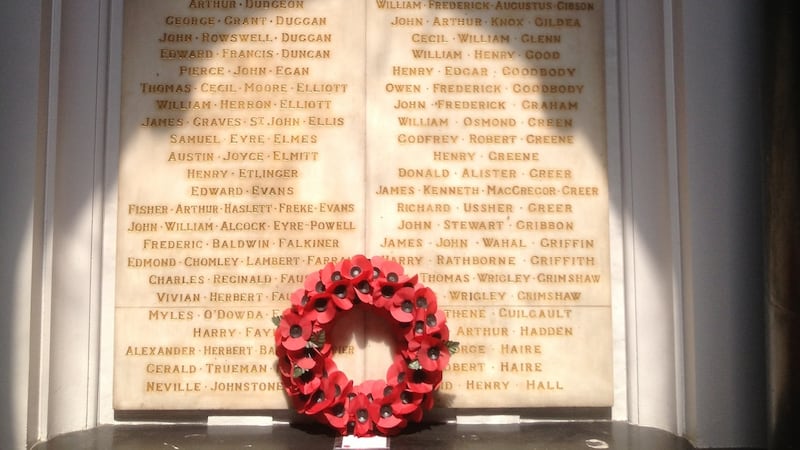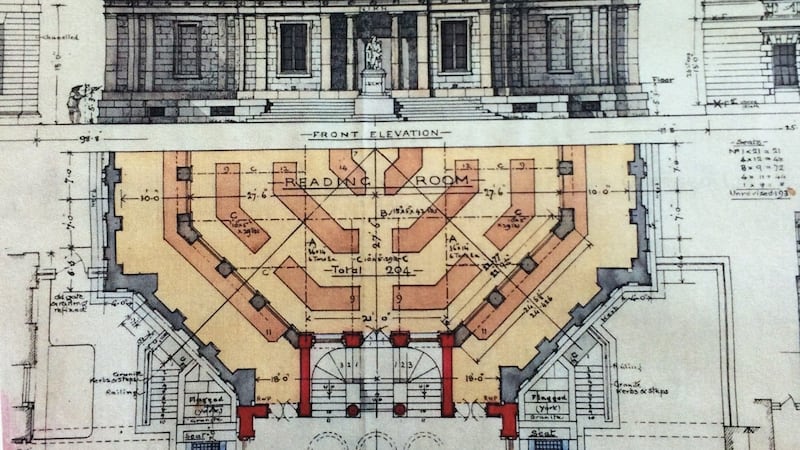Almost 100 years after Trinity College Dublin built a Hall of Honour to its dead of the first World War, the memorial will be completed on Saturday in what is being described as a rededication ceremony to roll back a century of collective amnesia within the university.
The ceremony will represent "an act of recovery by Trinity of a critical moment in its own history", according to John Horne, professor of modern European history and director of the Trinity Centre for War Studies.
He describes the rededication as “above all an act of reparation for the lost memory. . . of the Trinity men who died on the battlefields of the Great War”.


The ceremony, which will take place at 11am in the college's Front Square, will be attended by diplomats from the countries in which Trinity students, staff and alumni fought and died, along with guests and senior figures in the college's academic community, including provost Dr Patrick Prendergast. The keynote address will be given by Senator Ivana Bacik, Trinity's current Reid Professor of Law.
The ceremony, which will include a minute's silence and an uilleann pipe lament, will take place in front of the squat granite and Portland stone octagonal building sandwiched between the Examination Hall and the Long Room Library, known to generations of students as the 1937 Reading Room and more latterly the Postgraduate Reading Room.
A new Portland stone slab set on top of a hitherto vacant granite plinth in front of the building will be unveiled. The 1.2m by 1.2m by 400mm piece is engraved with an explanation in English and Irish.
Statue of Mars
The plinth was originally designed to host either a bronze lion seated or a statue of WEH Lecky, the historian, political theorist and poet, or a statue of Mars, the Roman god of war. However, none arrived and the space remained empty after the Hall of Honour, which was built in 1923, was inaugurated in 1928 and even after the octagonal reading room was added in 1937. Happily, Dr Lecky ended up close by in Library Square where he sits to this day.
The Hall of Honour is not normally accessible to the public. Its purpose was hinted at hitherto only by a word carved in stone on the facade of the Doric column portico – NIKH, a variation of the classical Greek word “Nike”, the goddess of victory, in this instance denoting victory over death.
Some 3,000 Trinity students, staff and alumni enlisted on the allied side in the war, most in the British army. The numbers were exceptional, according to Prof Horne, and only slightly fewer than the numbers enlisting from similar but larger universities, such as Oxford and Cambridge.
The 471 who died are remembered by name in the Hall of Honour, now a vestibule to the Reading Room.
The hall is made of Kilkenny black marble columns and white marble wall panels on to which are carved in gold lettering the names of the dead.
They include Ernest Julian (35), who was Reid professor and joined the so-called Dublin Pals, D Company of 7 Royal Dublin Fusiliers, and died on August 8th, 1915, at Chocolate Hill in Suvla Bay, Gallipoli; William Reeves Richards (24), also in the RDF, who died a week later at nearby Kiretch Tepe Sirt; Neville Johnstone Figgis (23), who died on August 10th at Gallipoli; and the Duggan brothers, George (29) and John (Jack) (21), the former an accomplished international athlete and founder of Trinity Week, both of whom died on August 16th at Suvla Bay.
The landings and fighting at Suvla Bay took a heavy toll on the Trinity troops, of whom 20 died in just two days, August 15th and 16th, 1915.
The Duggans’ father, also George, was manager of the Provincial Bank on College Street and during the Rising, narrowly escaped being shot by British soldiers. They relented only when Mr Duggan showed them photographs of George and Jack in uniform, thereby convincing them of his non-involvement in the rebellion.
Other names
Other names in the hall include Arthur Samuels, a barrister and former auditor of the College Historical Society who died in Hainaut in Belgium; brothers Arnold (28) and Donald (20) Fletcher, killed in France and Macedonia respectively, and George Marsh (37), a college porter, one of 37 non-academic staff who volunteered. Marsh died of shell shock in 1918.
When the hall, designed by Sir Thomas Manly Deane, was opened in 1928, Trinity’s vice- chancellor, Lord Glenavy, complained of a “growing conspiracy of silence” surrounding the memory of the war dead.
While today’s ceremony will draw attention to the memorial, there are no plans to have the Hall of Honour open to the public generally.
Dr Tomás Irish of the Centre for War Studies and author of Trinity in War and Revolution, 1912-1923, says: "This sends an unfortunate message which suggests that the college is uncomfortable with its role in the first World War, which was for so long a taboo issue in Irish history."









